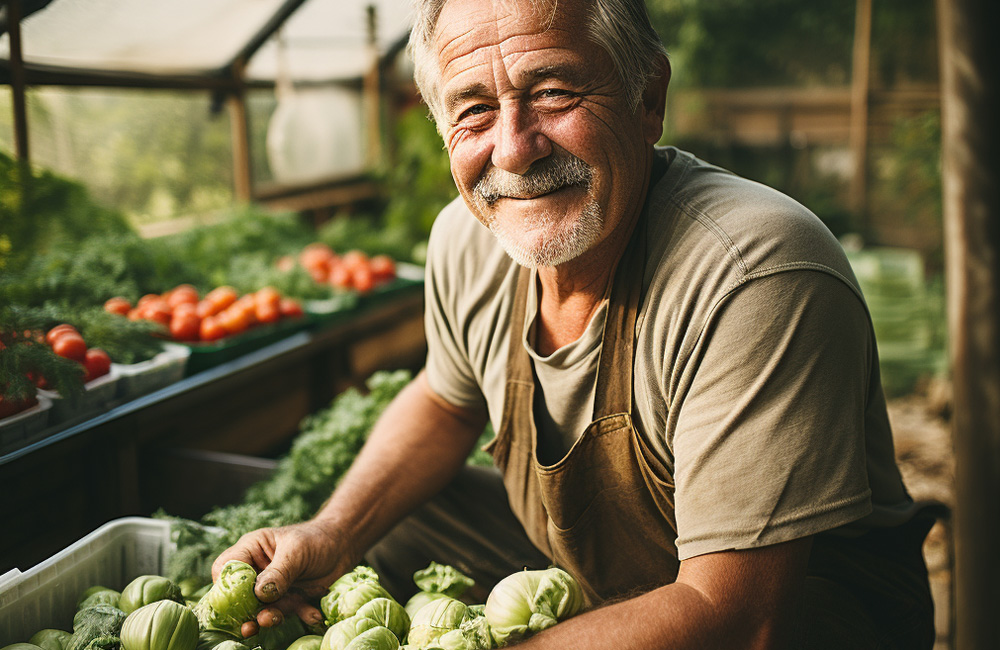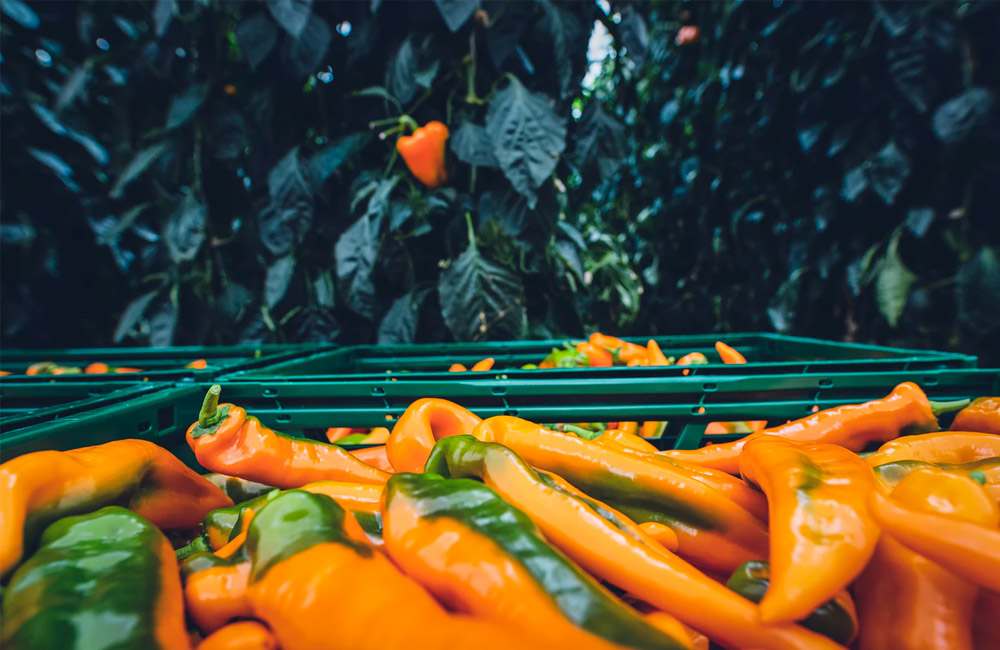Best Vegetables to Grow In A Greenhouse

Once the province of commercial growers, greenhouses and similar structures have made it to the mainstream and are more popular than ever.
Many homeowners are transforming outdoor gardens into indoor growing hubs.
Plants can be chosen for beauty, scent, or to supplement the home food supplies. Growing your own food is not only satisfying, it can save you on recurring grocery costs too.
Our Top Picks To Grow in a Greenhouse in the UK
Some vegetables grow better outside, as they have evolved or been developed to do well in your area. Other varieties have evolved in hotter climates or been developed to thrive in a greenhouse environment.
To help you determine where to plant each of your favourite crops the next time you plant, here are our top ten vegetables to be grown in greenhouses.
1. Peppers

Since nearly all pepper varieties occur naturally in hotter climates, they are idea candidates for greenhouse growing. Chillies, Jalapenos and Sweet Bells are popular choices, as they are excellent for perking up dishes without taking up huge amounts of space in the greenhouse.
Since peppers need a minimum nightly temperature of about 13 degrees Celsius, it is very risky to have them outside in the UK. Even in an unheated greenhouse, the added temperature generated by the shelter and clear walls is enough to keep peppers happy over a much longer season.
NEED A NEW GREENHOUSE? Visit South West Greenhouses << Free UK Delivery on top brands like Halls and Elite.
2. Tomatoes

Some tomatoes are best grown outdoors, but if you find a variety suited to the greenhouse environment, you will be able to harvest great returns for a much longer season than you’ll get outside – and with far fewer pests to worry about!
The best ones are those that grow mostly upward, rather than to the side, as you can train these and utilise your space to best effect.
3. Cucumbers

Cucumbers do well in the ground, in grow bags, or even in pots! There are a lot of varieties to choose from, some doing better inside and others outside, so choose according to where you plan to put them.
4. Root Vegetables

Though it is true that root vegetables like carrots and potatoes can grow outdoors quite well in the UK, growing them in a greenhouse means that you can plant mid-winter for a mid-spring harvest, and even keep production running well into the fall.
Start carrots close together, then thin them as they get larger, using the little ones in stir fries, stews, or even and fun snacks. They will be tender, sweet, and flavourful.
Beets are a versatile vegetable for cooking and baking and can be grown all year long in a suitable greenhouse.
5. Calabrese/Broccoli
This crop is well worth exploring. It’s easy to grow, grows very quickly, and is super healthy. Try Italian, green sprouting, or American broccoli varieties, but be aware, they can grow to be a lot bigger than what you’ll normally see in the grocery store – up to 60cm tall and 15cm across.
Harvest in autumn and summer and serve as part of a medley of summer-maturing vegetable crops.
6. Sweetcorn

Sweetcorn, like all really sweet vegetables, tastes best when very fresh. If you grow it in a greenhouse, you’ll have access to fresh, sweet, delicious sweetcorn just minutes from the stalk. You can grow a miniature variety to save on space – some varieties produce up to six cobs per plant, too.
Sweetcorn can be successfully grown outside too, if you’re in the right area, and want to conserve greenhouse space, start the plants indoors and then move them out once they’re ready. It’s the best of both worlds.
7. Squash
Squash is a wonderfully varied choice for your greenhouse growing. It comes in a wide variety of sizes, shapes and tastes, so you can try a bunch of them and home in on your favourites. Winter squashes include pumpkins and butternut squash, and when those summer months roll around you can enjoy yellow crookneck, yellow straight neck and scallop squashes.
Squash varieties are usually great growers and are an excellent choice for beginners and experts alike.
8. Brussels Sprouts
Brussels sprouts are a super food. Originating in the region in and around Belgium, they are super healthy and, as an added bonus, delicious! They also do well in cooler weather, so they’re great for harvesting in the winter months, when stocks of some other vegetables dip low. They do so well, in fact, that you can even harvest them after they’ve been through a frost, and they’re still great!
9. Lettuce

Lettuce can be a lot of fun in the garden, because it grows quickly, gets satisfyingly big and green, and is a delicious part of almost any meal – just pick some and add to a plate!
If you grow it in a greenhouse, you should be able to harvest all year long. Choose a couple of your favourite varieties to keep things interesting.
10. Peas

Some varieties of peas do best outdoors, while others are well-suited to greenhouse growing. Pick fresh peas from your own stock and they’ll become the stars of the meal. Try different types, such as mangetout, sugar-snap, or dwarf pea varieties.
What vegetables and plants should you grow as a beginner?
Don’t make the mistake of trying to grow everything!
Here are a few vegetables that are easy to grow for beginners in a greenhouse:
- Beetroot
- Broad beans
- Herbs
- Onions and garlic
- Peas
- Potatoes
- Runner beans
- Salad leaves
- Spring onions and radishes
- Tomatoes
The first step to starting your own greenhouse is to decide what you will grow. You should make an informed decision by researching the plants you are considering. Determining the best environments, temperatures and humidity levels that will be necessary for your plants to thrive is a crucial first step.
To help you get started, read the list of some of the easiest vegetables for beginners to grow. If your greenhouse is overcrowded none of your plants will produce significantly.
If you're getting started with gardening, then you may want to purchase a small greenhouse, or a smaller lean to greenhouse.
You can also learn more about buying a new greenhouse here.
Why do you need a greenhouse for veggies?
When you look out onto the green hedges, meadows and parks, you may wonder what the use of greenhouses is.
Why not just grow things outside?
The fact is that many of the foods we want to eat are from other parts of the world and can only grow outside here for a short time each year – if at all. By using a greenhouse, you can create a special habitat in your garden that is a little warmer and more favourable to these more delicate or demanding plants.
Greenhouses also protect from other potentially harmful conditions. They can keep out pests, like birds and rodents, which might otherwise tear up or devour your plants and crops.
Greenhouses can also decrease the amount of insect infestation, especially if you are careful to keep an eye out for the beginnings of a problem and take care of any potential problems before they get serious. Greenhouses are a barrier against heavy rain, hail and strong winds as well.
Add to this protection the warmer temperature inside such structures and it is easy to see the benefits.
Containers, Beds and Grow Bags - Where to plant?
You have a couple of different options when it comes to deciding what to grow your plants and vegetables in. Both options have their advantages and it really comes down to personal preference. You may choose to start a greenhouse with a soil floor. If you go this route and grow your plants in ground soil watering and fertilizing can be easier to manage. Alternatively, it will be easier to control weeds and soil borne diseases if you grow your plants in containers, grow bags, or bulb crates.
If growing from seed, then you can place seed containers onto greenhouse staging.
Getting Temperatures Right
It is crucial to keep your greenhouse at the correct temperature so your plants and vegetables can achieve their maximum growth potential. A thermometer will be an essential item for you as you begin growing in your greenhouse. Some plants and vegetables need more or less heat than others so it is imperative to research the plants you want to grow for the temperature they do best in. Check the temperature and humidity of your greenhouse on a regular basis and adjust as needed for the best growing potential.
Take some time to look into greenhouse heaters, vents and fans. All of these items will help ensure that the temperature is correct for your greenhouse and the plants you are trying to grow throughout the seasons.
And if it's getting too warm, then using greenhouse shading can help to manage it.
The Importance of Light
Do you want to grow your plants all year round? If you do, there are some things you will need to consider as far as lighting. It is easy to get enough natural sunlight in the late spring and summer but you may have to consider what you will do for extra lighting in the fall and winter months. You may decide to just hang a regular fluorescent strip 3 to 7 inches above your plants or invest in some LED grow lights.
Managing Space in the Greenhouse
Be aware that your crops will need enough space to fully grow properly. Your plants should be planted far enough away from each other that they do not touch. This is important for two reasons. Not only will you have a more difficult time getting them to grow if they are close together, plants that are too close together also encourage the spread of disease.
Ongoing Plant Care
Similar to heat and light, there are some plants that need more water than others. Do your research and ensure that you are giving your crops the optimal amount. You can purchase a water-butt to collect rainwater. Rainwater includes nitrates and organic matter so this is a great way to water your plants. Once you have the temperature and humidity under control in your greenhouse, the most important part to keeping your plants and crops happy and healthy is water!
Water your plants gently to avoid too much splashing. Splashing water may encourage the spread of disease amongst your plants.
There are a few unpleasant critters that like to hang out in greenhouses and may harm your plants such as bugs and slugs. Ensure your greenhouse is always clean, this will help control harmful critters.
There you have it! Everything you need to know to start growing your own vegetables in a greenhouse
Even wondered about starting an allotment? See our beginners allotment guide here.
Do you need a new greenhouse?
Here at South West Greenhouses, we've been supplying high quality greenhouses to people like you for years.
Click here to browse our greenhouse range now, with Free UK wide delivery.
 Author:
Author: